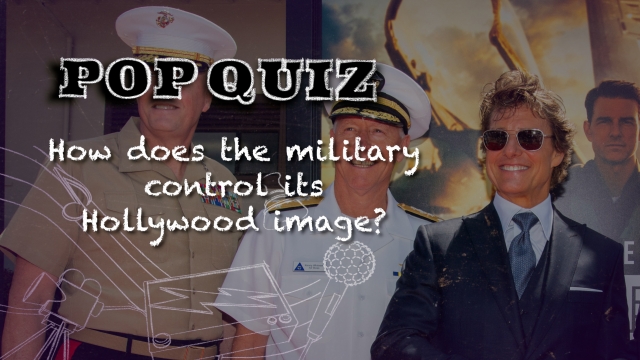
Entertaining? Yes. But also a certified fresh start
for the military industrial complex, in a starring role
Nick Cleveland-Stout /Responsible Statecraft
(June 2, 2022) — I’ll admit it. Top Gun: Maverick was pretty entertaining. Between the arbitrary sports montages and impressive air stunts, there lies a sympathetic plot centered around the personal relationship between Tom Cruise’s “Maverick” and Miles Teller’s “Rooster.”
And it seems like audiences agree, with the blockbuster movie grossing $160 million in its first four days in the US alone and enjoying a 99 percent audience score on the movie review site Rotten Tomatoes.
But if you look past the silver screen relationship between Maverick and Rooster, Top Gun: Maverick is, at its core, an unapologetically pro-military industrial complex film. The Washington Post reported that the film received support from the Pentagon itself “in the form of equipment — including jets and aircraft carriers — personnel and technical expertise.” In exchange for its help, the Navy even retained the power to veto things it didn’t like in the script.
Meanwhile, to defense contractors, the new Top Gun is certified fresh as a ticket to rehabilitation. Northrop Grumman celebrated the film by publishing a piece detailing their director of business development’s journey to being an extra in the original Top Gun. On LinkedIn, the CEO of Lockheed Martin James Taiclet boasted about going to the early premiere of the film, along with the VP of Skunk Works, Lockheed’s advanced development program. But Taiclet isn’t just an avid Tom Cruise fan, he is a collaborator on the project. In the same post, Taiclet wrote that Skunk Works “partnered with Top Gun’s producers to bring cutting-edge, future forward technology to the big screen.”

The opening scene features Maverick test-flying a hypersonic jet nicknamed “Darkstar,” a sleek black jet that observers believe is meant to resemble Lockheed’s experimental “SR-72” program. It was confirmed earlier this month that Lockheed Martin partnered with Skunk Works to design that plane, with director Joe Kosinski revealing that details of the plane were taken “out of real experimental aircraft.” Lockheed’s SR-72 has been in production since the early 2000s and is currently slated to roll out sometime around 2030.
The mission, should Maverick choose to accept it, is to fly F-18 jets to destroy a secret uranium enrichment bunker in a rogue state. While contemplating the viability of the mission, Cruise’s character remarks that the mission “would be a cakewalk for the F-35,” though it is ultimately ruled out. References to the F-35 like this are scattered throughout the film, despite the F-35 program’s 845 design errors, cyber vulnerabilities, $1.3 trillion sustainment costs, and mission capability rates at just over 55 percent.
No, talking about sustainment costs won’t get Maverick invited to dinner with the admiral, but the broader point is that films like Top Gun: Maverick allow defense contractors like Lockheed Martin, the manufacturer of the F-35, to paper over these failures by casting it in such a heroic light.
The sequel picks up right where the original left off, sending a clear message about the importance of a strong, active military. The indeterminate, unknown enemy leaves it up to the audience’s imagination as to where the mission even takes place. North Korea? Iran? Russia? Take your pick. Top Gun: Maverick’s “choose your own adventure” military foe is easily digestible to American audiences who grew up in a country with 750 bases, counterterrorism operations in upwards of 80 countries, and frequent preemptive drone strikes.

Let’s face it, Top Gun: Maverick gives the impression that projects like “Darkstar” are the only things preventing America from teetering on the brink of collapse at the behest of its nameless enemies. In this fictitious world, only with a dash of American military might and a sprinkle of characteristic Hollywood charisma can we continue to live in peace.
Only, it isn’t quite fictitious, given that this depicts the reality of consensus thinking in Washington. The original Top Gun helped America get over its Vietnam complex, rehabilitating the military in the public square. As American audiences crammed in to see Maverick’s flying antics 36 years ago, naval aviator applications reportedly increased by 500 percent. The sequel aims to recreate that, brushing aside the failures in Somalia, Iraq, Afghanistan, and Libya in the interim years to serve unabashedly as an infomercial for a romanticized version of the military, its contractors, and their mission.
Posted in accordance with Title 17, Section 107, US Code, for noncommercial, educational purposes.